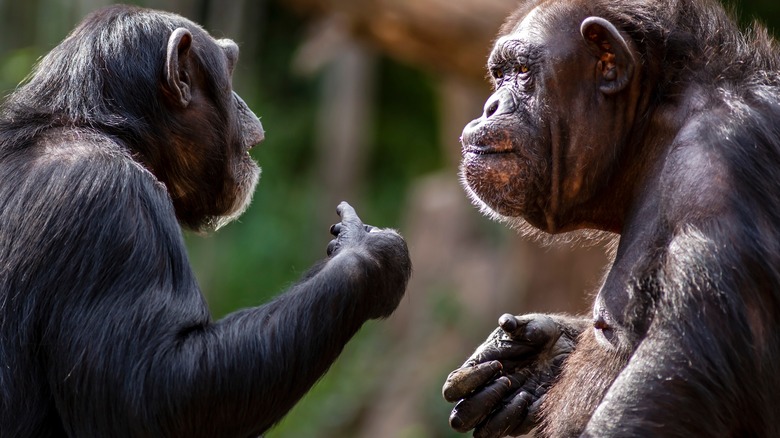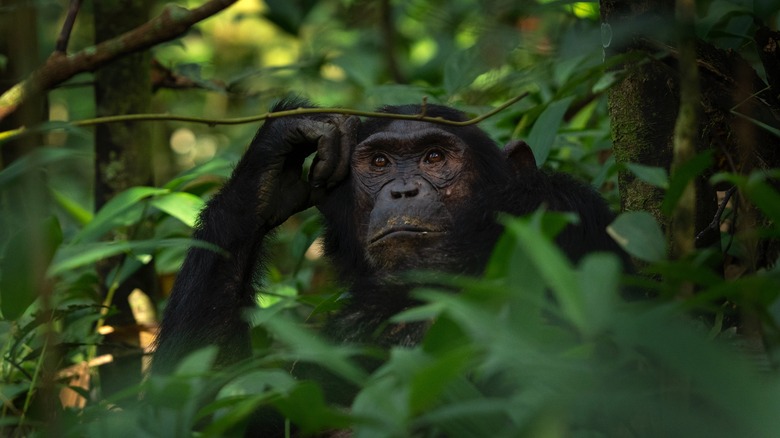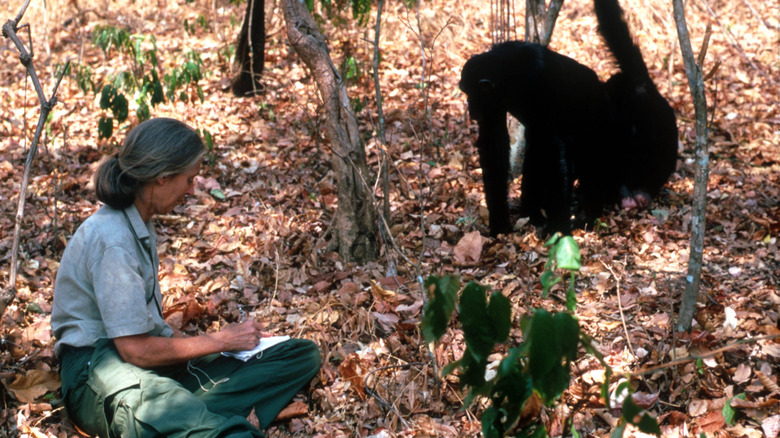Chimpanzees May Have Their Own Version Of Show And Tell
It's common for children and infants to share objects with a parent or sibling by giving, showing, or pointing. As simple as it may seem, such acts have been considered unique to humans, or at least more prominent in our social behavior, compared to that of our great ape cousins. A study released this month dents the belief that this behavior is unique to us, following in the canon of many primate studies in the past. The study, conducted by researchers at the University of Chicago, involved our closest cousins, the chimpanzees. Reportedly, the event occurred when an adult chimp in Kibale National Park, Uganda, was sitting near her mother when she decided to pick up a leaf and show it to the mother, much as a human child would do (via CNN).
The seemingly rudimentary behavior says something about chimps that many scientists have denied: Chimpanzees can share an experience with other chimps just for the sake of doing so. Before this study, our closest cousins have only been seen referring to objects when they have something obvious to gain. According to the study, the leaf-holding chimp, dubbed "Fiona," had not "gestured to engage in food sharing or to initiate dyadic play (play between two individuals) or grooming interactions," per The National Academy of Sciences.
Background of the show-and-tell study
This year's study focused on what is called "referential gesturing," but this phenomenon has been researched before in chimpanzees. The behavior largely appeared while they were held in captivity. In 2014, a study showed that great apes in captivity often used referential gestures to obtain an object from a human caretaker or fellow chimp. This led researchers to think that sharing attention for its own sake was limited to humans, despite some observations in this vein being recorded in the wild. Its rarity in nature, however, seemed unusual given that the behavior was in their repertoire (per The National Academy of Sciences).
At the time of Fiona's breakthrough gesture, she was doing what's called "leaf grooming," a behavior that chimps engage in when they're grooming each other or themselves. While the chimp plucks parasites from the body of their or another chimp, she might grab leaves nearby and manipulate them with her mouth and fingers. Leaf grooming mimics the normal grooming process, but its function isn't fully understood, according to the recent study's authors. While she groomed a sapling's leaf, Fiona held out her arm toward her mother, only to be ignored. But once she persistently repositioned her arm, she caught the elder's attention and then drew back her arm once the former looked at the leaf. The researchers were convinced that this resembles human efforts to share information (as per The National Academy of Sciences).
Are great apes more like us than we think?
In his 2016 book "Are We Smart Enough to Know How Smart Animals Are?," primatologist Frans De Waal discussed an approach in ethology (the study of animal behavior, per Britannica) that emphasized the function of animal behavior, specifically survival. Much of this functional approach was an attempt to resist anthropomorphism (assigning human traits to other animals). Although it's not unusual to see uncannily human behaviors in pets and wildlife, early scientists dismissed the comparisons as folk beliefs. Therefore, the study of animal behavior tried to steer as far from such interpretation as possible.
But given the close genetic relationship between humans and other mammals, especially the great apes, it makes sense to question if we're anthropomorphizing or just seeing how connected we are to our fellow primates. Since Jane Goodall discovered tool use and hunting in chimpanzees, closer looks at our chimp cousins have helped bridge the gap between humans and animals (per National Geographic). Now, in the field of ethology, even looking closely at minute, seemingly insignificant details can strip away bits of our hubris. Katie Slocombe, a co-author of the study, expressed hope that researchers will look again at their footage to see what minutiae they may have missed. She said (via CNN), "Maybe then, we can actually start to get multiple examples to really better test whether the motivation of the chimps is similar to humans."


